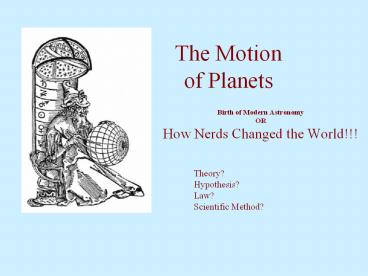The Motion of Planets - PowerPoint PPT Presentation
1 / 30
Title: The Motion of Planets
1
The Motion of Planets
- Birth of Modern Astronomy
- OR
- How Nerds Changed the World!!!
Theory? Hypothesis? Law? Scientific Method?
2
How is science done?
- Observations
- Experiments
- Explanations
- Theories
- Laws
- Repeat
3
Assumptions of Early Models
- Geocentric - Earth in the middle
- Everything orbits the Earth
- Stars are located on the Celestial Sphere
- Everything moves in uniform circular motions
4
The Greeks
- Anaximander
- Celestial sphere rotates around the earth
- Pythagoras
- Earth is a sphere
- Eudoxus
- Planet motion accounted for by separate spheres
- Aristotle
- Complete model of the universe (4 elements)
- Perfect heavens
- Apollonius
- epicycles
5
The Time of Aristotle
6
Model of the Universe
- All things in the universe go to their Natural
Place
Element Natural Motion Properties
Earth Falls down Dry, Cold
Air Rises up Wet, Hot
Water Falls down Cold, Wet
Fire Rises up Hot, Dry
7
Hellenistic (Greek)Periodic Table
8
Retrograde Motion
9
The problem of Retrograde Motion Apollonius
- The motion of these spheres did not account for
retrograde motion. - Apollonius introduces epicycles
- Roughly meaning cycles within
10
What is an epicycle?
Epicycle
- The Center of of epicycle revolves around the
earth - The planet spins along the epicycle at the same
time.
Mars
Earth
Deferent
11
Enter the Roman Ptolemy
- Brought it all together
- Added the equant to adjust the model to match
observations - Wrote The Mathematical Compilation
- Destruction of Library of Alexandria
- (Europe lost almost all its written knowledge)
- The Arab Scholars called it Almagest (the
greatest) - This is how they came to know it once the work
returned to Europe.
12
Epicycle
Mars
Equant
Claudius Ptolemy (87-165)
Earth
Deferent
13
The Dark Ages
14
Nicolaus Copernicus (1473-1543)
Errors building up Must be a better way! Lets
try a Heliocentric system! Not any better though
15
(No Transcript)
16
Tycho Brahe (1546-1601)
Comet beyond the Moon Supernova far
away Naked eye observations of planets Accuracy
through repetition Best observations of planetary
positions Hired nerd to help calculate model
Died.
17
Johannes Kepler (1571-1630)
Worked for Brahe Took data after his death Spent
years figuring out the motions of the
planets Came up with
Three Laws of Planetary Motion
18
1. Planets move in elliptical orbits with the Sun
at one foci
Sun
Perihelion
Aphelion
Foci (sing. Focus)
Average distance from the Sun 1 Astronomical
Unit (1 A.U.)
19
2. Planets move faster at perihelion than at
aphelion.
1 Month
1 Month
20
3. Period is related to average distance
P period of the orbit a average distance P2
k a3 Longer orbits - greater average
distance Need the value of k to use the formula k
depends upon the situation Can be used for
anything orbiting anything else
21
Special version of Keplers third Law If the
object is orbiting the Sun P measured in years,
a measured in A. U., then. P2 a3
22
Galileo Galilei (1564-1642)
Knew of Copernicuss Keplers work Used a
telescope to look at the sky What did he see?
23
The Moon was an imperfect object
Venus has phases
24
Jupiter has objects around it
Saturn is imperfect
The Sun is imperfect
25
Isaac Newton (1642-1727)
The ultimate nerd Able to explain Keplers
laws Had to start with the basics - The Three
Laws of Motion
26
1. Law of Inertia - Objects do whatever they are
currently doing unless something messes around
with them.
27
2. Force defined Fma Fforce mmass aacceleratio
n (change in motion)
28
3. For every action there is an equal and
opposite reaction.
The three laws of motion form the basis for the
most important law of all (astronomically
speaking) Newtons Universal Law of Gravitation
29
Fforce of gravity Gconstant M1, M2
masses Rdistance from centers Gravity is the
most important force in the Universe
30
- Newtons Revisions to Keplers Laws of Planetary
Motion - Keplers 1st and 2nd Laws apply to all objects
(not just planets) - 3rd Law rewritten
- 4p2 and G are just constant s (they dont
change) - M1 and M2 are any two celestial bodies (could be
a planet and Sun) - Importance if you know period and average
distance of a planet, you can find mass of Sun (2
x 1030 kg) or any planet!
Mass of Sun is 2 000 000 000 000 000 000 000 000
000 000 kg Mass of Earth is 6 000 000 000 000 000
000 000 000 kg Mass of Mr. J is 100 kg! WOW!































